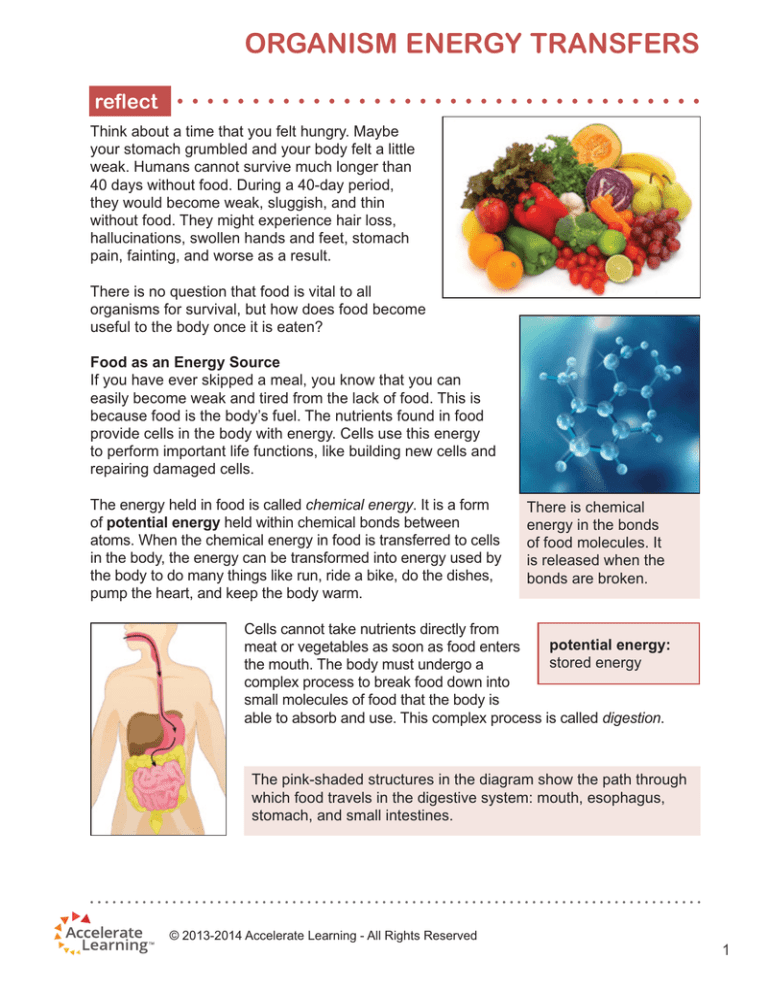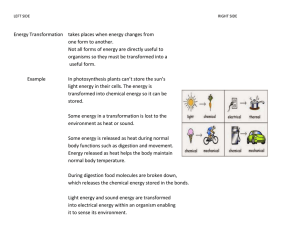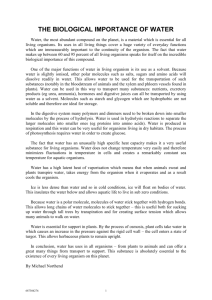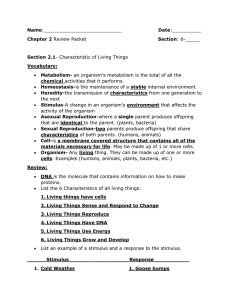
ORGANISM ENERGY TRANSFERS
reflect
Think about a time that you felt hungry. Maybe
your stomach grumbled and your body felt a little
weak. Humans cannot survive much longer than
40 days without food. During a 40-day period,
they would become weak, sluggish, and thin
without food. They might experience hair loss,
hallucinations, swollen hands and feet, stomach
pain, fainting, and worse as a result.
There is no question that food is vital to all
organisms for survival, but how does food become
useful to the body once it is eaten?
Food as an Energy Source
If you have ever skipped a meal, you know that you can
easily become weak and tired from the lack of food. This is
because food is the body’s fuel. The nutrients found in food
provide cells in the body with energy. Cells use this energy
to perform important life functions, like building new cells and
repairing damaged cells.
The energy held in food is called chemical energy. It is a form
of potential energy held within chemical bonds between
atoms. When the chemical energy in food is transferred to cells
in the body, the energy can be transformed into energy used by
the body to do many things like run, ride a bike, do the dishes,
pump the heart, and keep the body warm.
There is chemical
energy in the bonds
of food molecules. It
is released when the
bonds are broken.
Cells cannot take nutrients directly from
potential energy:
meat or vegetables as soon as food enters
stored energy
the mouth. The body must undergo a
complex process to break food down into
small molecules of food that the body is
able to absorb and use. This complex process is called digestion.
The pink-shaded structures in the diagram show the path through
which food travels in the digestive system: mouth, esophagus,
stomach, and small intestines.
© 2013-2014 Accelerate Learning - All Rights Reserved
1
ORGANISM ENERGY TRANSFERS
In humans, the first step in digestion is chewing. Teeth and saliva in the mouth begin
to break down food into small pieces. Mechanical digestion occurs when the teeth
physically break down the food. Chemical digestion occurs when substances in saliva
chemically break down the food.
From the mouth, food travels through the esophagus to the
esophagus: a tube that
stomach where more chemical digestion takes place. Strong
moves food from the
chemicals break food down even further into individual
mouth to the stomach
molecules, like proteins and fats. From the stomach, the food
molecules move into the small intestine. This is where much
of the chemical energy from food is absorbed into your body for use by the cells.
look out!
Animals, including humans, get chemical energy from
plants. Even when animals eat meat, the chemical energy
held in the meat came from the food that the animal ate. For
example, cows get their energy by eating grass. When a
person eats steak, the chemical energy from the steak first
came from grass eaten by the cow. All food originates with a
plant. But where do plants get their energy? From the Sun,
of course! Plants transform, or change, energy from sunlight
(solar energy) into chemical energy through photosynthesis.
photosynthesis:
the process by which
plants (and some other
organisms) use sunlight
to make food from
carbon dioxide and water
what do you think?
The source of energy in most food chains on Earth begins with the Sun. Write the names
of the missing organisms to show how energy moves through the food chain, finishing with
the girl eating a beef hamburger.
Transforming Chemical Energy to Mechanical and Thermal Energy
The chemical energy stored in food is a type of potential energy. Therefore, it can be
transformed into kinetic energy. This transformation happens during chemical reactions
that take place when the body digests food. Recall that during
digestion, large food particles are broken down into small
kinetic energy:
individual molecules like proteins and fats. These molecules
energy of motion
may be moved through the intestinal lining into the bloodstream.
© 2013-2014 Accelerate Learning - All Rights Reserved
2
ORGANISM ENERGY TRANSFERS
Once the molecules have moved into the bloodstream, the
chemical energy in food is transformed into thermal energy.
Thermal energy is used to keep the body warm and maintain
a normal body temperature of about 98.6°F (37°C.) Chemical
energy from food molecules (potential energy) may also be
transformed to mechanical energy (kinetic energy) when the
body moves. In every energy transformation, some energy
is given off as heat. This is why the body warms up during
different activities like exercising, lifting weights, and even
digestion!
thermal energy: total
kinetic energy within
the particles of a
substance
mechanical energy:
energy an object has
because of its motion
(or position)
what do you think?
How will the girl use energy from the food she is eating? Draw the next step of energy
transformation from the chemical energy in the girl’s hamburger to the mechanical energy
of movement. Be creative!
Looking to the Future: Food as Fuel for More than
Just Bodies
Every day, animals transform the chemical energy
held in food into mechanical and thermal energy.
In recent years, scientists have begun to apply this
process to nonliving objects that run on fuel such
as cars, trains, and buses. They have developed a
fuel source known as biofuels, which are fuels made
from living organisms like plants and algae. The
use of biofuels has many important benefits. They
are generally cleaner to burn than other fuels like gasoline,
which means they don’t release as many harmful gases such
as carbon dioxide into the atmosphere. Biofuels are also
renewable. They are often made of corn. These crops yield
high amounts and can be replanted each year.
renewable: able to
be replaced
© 2013-2014 Accelerate Learning - All Rights Reserved
3
ORGANISM ENERGY TRANSFERS
A large American chemical company recently announced that it plans to build a factory to
produce biofuel in Iowa over the next few years. The factory will use corn stover, the stalks
and leaves not used for animal feed, to generate a specific biofuel called cellulosic ethanol.
The factory will be one of the first of its kind, but hopefully it will be the first of many to
come.
What do you know?
Organisms undergo energy transformations so that they can obtain necessary energy from
food. The boxes below describe how the body transforms food into usable energy. Fill in
the missing blanks in each box describing how energy is transformed in organisms. Then,
number the boxes in the correct order that they would occur. Write the number at the end of
each description inside the box.
In an animal’s body, chemical energy from food is
, which is used
changed into
to keep the body warm. The body also transforms
for
chemical energy into
activities involving movement.
Energy from the sun is transformed
in plants
into
through photosynthesis.
Organisms eat plants, and energy
is passed from plants to an animal
.
through a
© 2013-2014 Accelerate Learning - All Rights Reserved
4
ORGANISM ENERGY TRANSFERS
connecting with your child
Energy Transformations Within You
To help students learn more about how
food is used as fuel through energy
transformations, encourage them to keep
a food diary of their daily meals. Have
students pay attention to the foods they eat
at each meal, focusing on which types of
foods will provide them with lots of energy
and which will make them feel lethargic.
Teach students to read food labels and
explain that in nutritional contexts, calories
represent how much energy a food item
contains. Let them know that a teen burns
about 175 calories in 30 minutes of bike
riding. Food that is not used for energy gets
stored in the body as fat. Ask students how
they can use this information when reading
food labels.
Here are some questions to discuss with
students:
• What foods provide the most energy to
the body?
• Does the body use all the chemical
energy it is provided? What happens to
the energy not used?
• Why do organisms have to eat on a
regular basis?
• How are thermal energy and mechanical
energy related?
Then, have students research the diets
that professional athletes follow when they
are training for sports. Suggestions include
Olympic swimmers and marathon runners.
Ask students to draw correlations between
the types of foods they eat during regular
training and the types they eat just before a
big competition. What does this say about
the chemical energy held in foods high in
carbohydrates?
© 2013-2014 Accelerate Learning - All Rights Reserved
5



